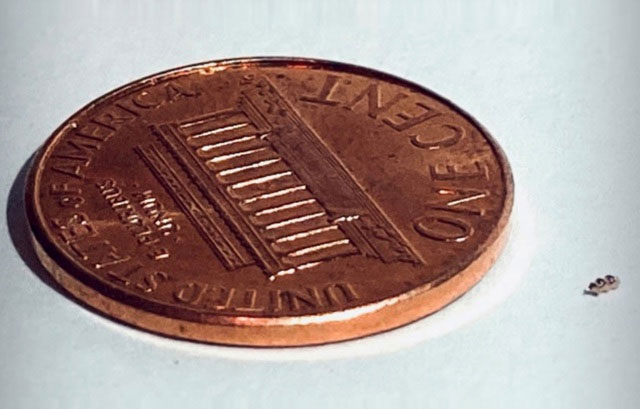Effective cancer treatment thanks to micro-robots
A team of researchers has found a very promising way, seemingly only needing tiny robots with special functions to bring life to cancer patients.
Over the past few decades, cancer treatments have advanced dramatically. Many types of cancer no longer hold the same high mortality rate as before, thanks to medical interventions that slow or stop the growth of tumors, and even eliminate them completely. Despite this, in many countries, cancer remains the second leading cause of death, after heart disease, and there is still no cure for all or most cases of cancer.

A tiny Bionaut robot sits next to a coin.
Recently, a group of researchers at Bionaut Labs, California, USA, have found a very promising way, it seems that only small robots with special functions can bring life. for cancer patients.
As small as a speck of dust , this robot is a drug delivery system to tumors in the body. This idea at first sounded like a science fiction story, it even appeared in a few movies or story books about chips or robots embedded inside the human body to control. works or cures disease, but this new research is indeed a valuable invention in the treatment of cancer. Bionaut Labs wants to eliminate the imprecise nature of most cancer treatments by using microscopic robots shaped like a screw.
This research is based on a very simple idea. These are tiny robots that can be inserted into the human body without complicated surgery. Once in the body, the screw-like shape will help the robot direct towards the tumor thanks to external magnets that create a magnetic field.
X-ray observations will help doctors monitor the robot's movement and activity to make sure they go straight to the growing tumor. When reaching the destination, the robot will receive commands also through magnets, to inject the drug into the right tumor, maximizing the effectiveness of killing cancer cells and minimizing side effects.
Compared to the oral or injectable therapeutic approach, we may find this new approach to be more beneficial. Normally, to get to the tumor, drugs have to go through the circulatory system, and that means the chemotherapy spreads throughout the body. This treatment works but also has many side effects and is not as effective as using a robot to deliver drugs directly to the tumor.
What's most exciting about this new study is that it's not a fantasy, but actually a technology that's already been invented and is being proven to work in the real world. Now, researchers are targeting a number of specific cancers that affect the brain stem. The robots will be injected into the spinal cord in a convenient position to help the robot move to the part with cancer cells. The next target will be other types of cancer.
As expected by the team, they will conduct clinical trials in early 2023 to pave the way for the approval process to officially recognize this as one of the worldwide cancer treatments.
- Put the micro algae robots into the body to spy on and treat cancer
- The 'army' of microscopic robots looks for cancer cells
- Detection of enzymes for effective treatment of kidney cancer
- Micro-robot warrior looking for cancer cells
- 'Chiêu' new treatment for liver cancer
- Vietnam has successfully treated liver cancer with radioactive microspheres
- The secret of cancer room consists of only 2 things, everyone can do it
- 8-year-old baby found a cure for cancer effectively
- Introduce robot can learn as human brain
- Thinking is deep, who would expect it to be the savior of man in the future
- Research on 'psychoactive drugs' for cancer treatment
- Compound from magnolia can treat head and neck cancer
 Why is Australia the country with the highest cancer rate in the world while Vietnam ranks 100th?
Why is Australia the country with the highest cancer rate in the world while Vietnam ranks 100th? New drug causes cancer to 'starve'
New drug causes cancer to 'starve' Common cancers in men
Common cancers in men America's incredible discovery: The most feared cancer cell is love
America's incredible discovery: The most feared cancer cell is love